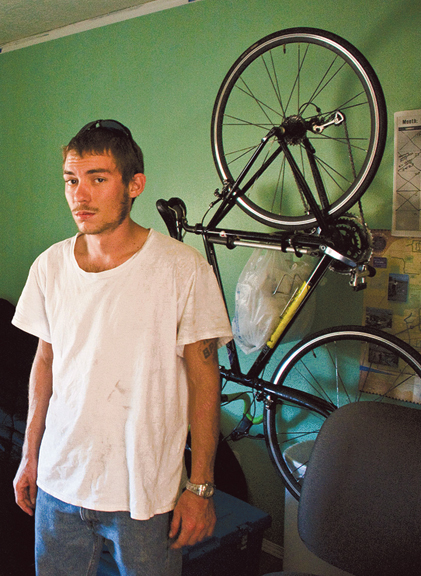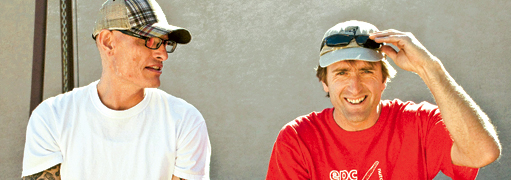Jesse was far from home last winter, detoxing at a rehab facility in in the Midwest. The 23-year-old recovering addict returned to New Mexico to take up residence at the Endorphin Power Company. At the transitional living facility, exercise helps addicts kick their habits, replacing the euphoria of drugs with endorphins. "I got out of rehab in Michigan and only had my bike for transportation," he says. "I’ve always ridden my bike. When all your money goes to drugs and alcohol, it’s hard to save up for a car." While at Endorphin Power Company, Jesse (who asked that we omit his last name) began biking along Tramway and into the mountains. He enrolled at CNM and also began biking to and from school. On June 5, he completed a 65-mile ride during Albuquerque’s Tour de Cure, a fundraiser for the American Diabetes Association.The cycling event was his first. Jesse entered after seeing a flyer that a volunteer from the race posted at the center. "Just completing it was the accomplishment," he says.Jesse’s story exemplifies one of the tenets of Endorphin Power Company’s distinctive "four-pillar" program: the idea that exercise is a vital and scientifically proven part of substance-addiction recovery. It’s important to replace the drug high with “endogenous morphine" or endorphins, founder Sam Slishman says. Dr. Slishman and Program Director Jeff Holland talk about using exercise to short-circuit the tendency in an addict’s brain to gravitate toward substances. It could be a way of replacing one form of addiction with another; Slishman says he would much rather see the people in his community become "workout junkies." A runner’s high is a way to "create a new default button," Holland adds.Since the center opened in 2003, Slishman has wanted his facility to generate its own electricity . On Saturday, Nov. 5, the Endorphin Power Company showcased its first five exercise bikes that hook up to a generator. When residents turn the wheels, they generate power that helps run the facility. The stationary bikes, which cost about $4,000 each, were purchased from Green Revolution, an East Coast manufacturer of exercise machines that double as energy generators. A sixth bike is slated to arrive in the next couple of weeks.The unveiling of the bikes is a long time coming, and the concept, controversial. Articles in 2004 and 2005 from the Albuquerque Journal and Chuck Shepherd’s nationally syndicated "News of the Weird" made Slishman out to be a crackpot mad scientist. Energy-generating bikes powered by recovering addicts were presented as a wacky pipe dream.But Slishman is quick to forgive. "In 2004, we had nothing to show," he says.Along with the bikes housed in the center’s well-furnished 24-hour gym are other green-friendly energy solutions, such as a solar-powered outdoor climbing wall that, after rotating 90 degrees, doubles as a stage. Endorphin Power Company also has energy-use monitors in each of the center’s 19 residential rooms.While Holland and Slishman would like to generate enough energy to fully power the place and sell some back to the PNM, the reality is that they are far from that goal. To put it into context, riding one of the bikes only creates enough energy to power a 100-watt light bulb for an equivalent amount of time. While they work on more effective ways to generate energy, powering the center’s residential complex—as well as its library, art gallery, gym and offices—is a tall task.Regardless, Endorphin Power Company boasts eclectic offerings, including improv classes, multiple daily recovery meetings and a close-knit support community. The tab for the rent and all amenities comes to around $400 a month for residents. But being an affordable nonprofit with a highly selective process of admitting residents has its costs."Right now we operate at about a $2,000 to $3,000 a month deficit," Holland says. "We are desperately seeking funding." Slishman’s name is on the mortgage, so if the project crashes, he’s the one on the hook. Adding to the pressure, Health Care for the Homeless’ transitional facilities are in danger. Downtown’s Tierra del Sol closed in October. Casa los Arboles and Villa de Paz are slated to shut their doors by Dec. 31. Anita Cordova is the associate director of Health Care for the Homeless. She confirms that unless someone takes over the two remaining transitional living facilities, they will shut down. Health Care for the Homeless is in the process of moving residents to alternate sites, Cordova adds.These closings will affect 300 people a year seeking recovery, Holland estimates, and will lengthen the already long wait list at Endorphin Power Company. The waiting period is between one and three months, and Holland says he expects that to double or triple by the time all of Health Care for the Homeless’ residential facilities have closed. But Holland sees the "ripple effect" of these closings as much farther reaching. "It’s gonna effect the community in a way we’re not gonna realize for awhile. … This is setting things back five to 10 years."







